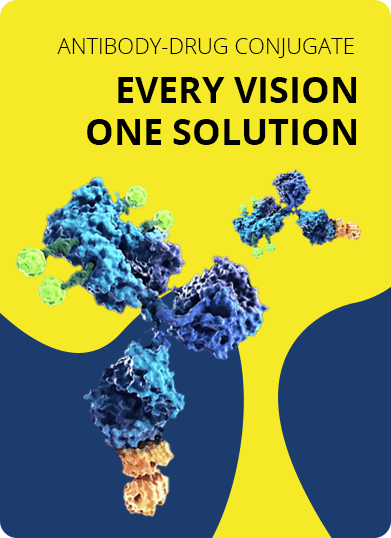- Home
- Resources
- Knowledge Center
- Protocols
- The Strategy of Click Chemistry Conjugations
The Strategy of Click Chemistry Conjugations
Over the past decade, scientists have discovered from extensive ADC drug validation studies that the drug-to-antibody ratio (DAR) and the drug conjugation site significantly influence the pharmacokinetics and therapeutic index of ADCs, thereby determining the success or failure of drug development. Therefore, chemistries enabling the synthesis of homogeneous ADCs with site-specific binding can greatly enhance the success rate of ADC drug development. Click chemistry allows for precise control of modification sites within biomolecules, thus finding widespread applications in bioconjugation.
This article provides a brief introduction to conjugation methods based on carbonyl-aminooxy coupling and strain-promoted azide-alkyne cycloaddition reactions, aiming to assist researchers in further understanding click chemistry.
Disclaimer
This procedure is a guideline only. Please note that Creative Biolabs is unable to guarantee experimental results if it is conjugated by the customer.
- Oxime Ligation
Material:
Acetate buffer, pH 4.5: 0.1 M sodium acetate, pH 4.5
Dimethyl sulfoxide (DMSO)
Aminooxy-functionalized drug-linker
Carbonyl-functionalized antibody
PBS: 10 mM sodium phosphate, 150 mM NaCl, pH 7.4
4-amino-DL-phenylalanine
Desalting column
50 kDa weight cut-off (MWCO) ultracentrifugal filter
0.2 μm syringe filter
Procedure:
You can choose either of the following two methods:
A. Perform the coupling reaction at an acidic pH:
1. Use a desalting column to exchange the purified carbonyl-functionalized antibody into a 0.1M acetate buffer (pH 4.5).
2. Prepare a 26.7 mM stock solution of an aminoxy-functionalized drug-linker in DMSO.
3. To 10 mg of carbonyl-functionalized antibody in acetate buffer, add 50 μL of 26.7 mM aminooxy drug-linker stock. Make the final volume of the sample to 1 mL.
4. Allow the sample to incubate at 37°C for 1–4 days.
5. Place the sample in a desalting column equilibrated with PBS to remove excess drug-linker.
6. Concentrate the ADC sample using a protein concentrator with a 50 kDa MWCO.
7. Filter the purified conjugate using a 0.2μm syringe filter.
8. ADC samples can be stored at -20°C to -80°C until use.
B: Perform the coupling reaction under neutral pH conditions in the presence of a catalyst:
1. Use a desalting column to exchange the purified carbonyl-functionalized antibody into neutral PBS buffer (see Note 1).
2. Prepare a 26.7 mM stock solution of an aminoxy-functionalized drug-linker in DMSO.
3. Prepare a 50 mM stock solution of 4-aminophenylalanine in PBS.
4. Add 50μL of 26.7 mM aminoxy drug-linker for 10 mg of carbonyl-functionalized antibody in PBS and also add 200μL of 50 mM 4-amino-phenylalanine as catalyst (see Note 2), to achieve a final concentration of 10 mM. Make the final volume of the sample to 1 mL.
5. Allow the sample to incubate overnight at 4°C (see Note 3).
6. Place the sample in a desalting column equilibrated with PBS to remove excess drug-linker.
7. Concentrate the ADC sample using a protein concentrator with a 50 kDa MWCO.
8. Filter the purified conjugate using a 0.2 μm syringe filter.
9. ADC samples can be stored at -20°C to -80°C until use.
Note:
1. Avoid using amine-containing buffers, such as Tris or glycine.
2. Aniline or other aniline derivatives can be used as alternative catalysts, typically within the range of 10 mM to 100 mM.
3. It is recommended to perform analysis using LC-MS or hydrophobic interaction chromatography (HIC) to ensure coupling is completed within the suggested time frame.
- SPAAC Ligation
Material:
Azide-functionalized antibody
Aza-dibenzocyclooctyne (DBCO)-functionalized drug-linker
Dimethyl sulfoxide (DMSO)
PBS: 10 mM sodium phosphate, 150 mM NaCl, pH 7.4
Desalting column
50 kDa weight cut-off (MWCO) ultracentrifugal filter
0.2 μm syringe filter
Procedure:
1. Take the purified antibody functionalized with azide groups and perform buffer exchange using a desalting column equilibrated with PBS (see Note 4).
2. Prepare a stock solution of 26.7 mM DBCO-functionalized drug-linker in DMSO.
3. Add 50μL of 26.7 mM DBCO-functionalized drug-linker in PBS to 10 mg of azide-functionalized antibody and make up the final volume of the sample to 1 mL.
4. Allow the sample to incubate at room temperature for 2 hours.
5. Place the sample in a desalting column equilibrated with PBS to remove excess drug-linker.
6. Concentrate the ADC sample using a protein concentrator with a 50 kDa MWCO.
7. Filter the purified conjugate using a 0.2 μm syringe filter.
8. ADC samples can be stored at -20°C to -80°C until use.
Note:
4. Avoid using buffers containing azides (such as sodium azide). Buffers other than PBS with a buffer range close to neutral pH can be used.
Check out our DAR and Payload Distribution Analysis and Drug-Linker Synthesis Services to streamline your bioconjugation experiments.
For Research Use Only. NOT FOR CLINICAL USE.

Online Inquiry
Welcome! For price inquiries, please feel free to contact us through the form on the left side. We will get back to you as soon as possible.
